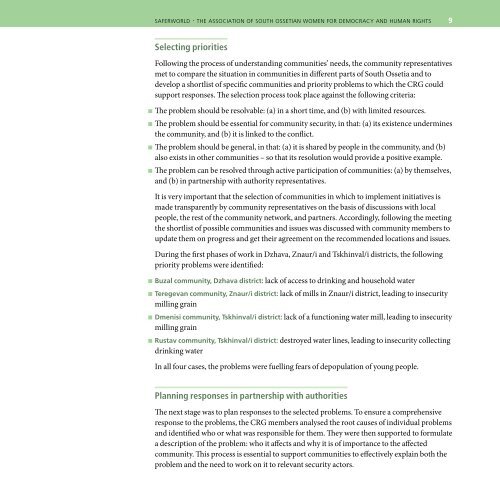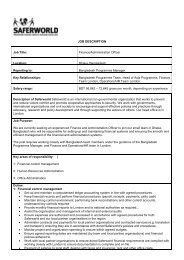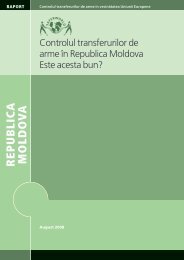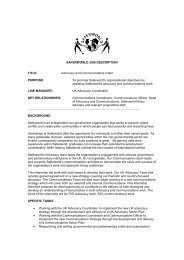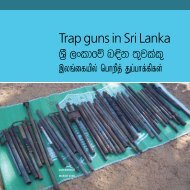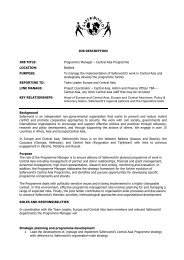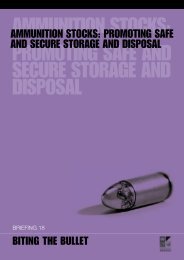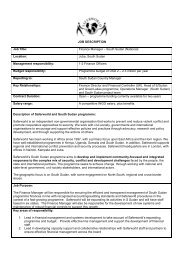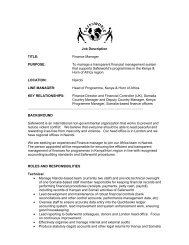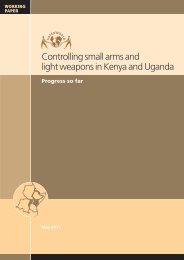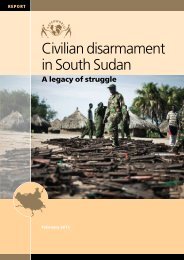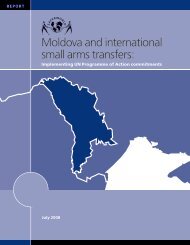Empowering conflict- affected communities to respond ... - Saferworld
Empowering conflict- affected communities to respond ... - Saferworld
Empowering conflict- affected communities to respond ... - Saferworld
- No tags were found...
You also want an ePaper? Increase the reach of your titles
YUMPU automatically turns print PDFs into web optimized ePapers that Google loves.
s a f e r w o r l d · t h e a s s o c i a t i o n o f s o u t h o s s e t i a n w o m e n f o r d e m o c r a c y a n d h u m a n r i g h t s 9Selecting prioritiesFollowing the process of understanding <strong>communities</strong>’ needs, the community representativesmet <strong>to</strong> compare the situation in <strong>communities</strong> in different parts of South Ossetia and <strong>to</strong>develop a shortlist of specific <strong>communities</strong> and priority problems <strong>to</strong> which the CRG couldsupport responses. The selection process <strong>to</strong>ok place against the following criteria:n The problem should be resolvable: (a) in a short time, and (b) with limited resources.n The problem should be essential for community security, in that: (a) its existence underminesthe community, and (b) it is linked <strong>to</strong> the <strong>conflict</strong>.n The problem should be general, in that: (a) it is shared by people in the community, and (b)also exists in other <strong>communities</strong> – so that its resolution would provide a positive example.n The problem can be resolved through active participation of <strong>communities</strong>: (a) by themselves,and (b) in partnership with authority representatives.It is very important that the selection of <strong>communities</strong> in which <strong>to</strong> implement initiatives ismade transparently by community representatives on the basis of discussions with localpeople, the rest of the community network, and partners. Accordingly, following the meetingthe shortlist of possible <strong>communities</strong> and issues was discussed with community members <strong>to</strong>update them on progress and get their agreement on the recommended locations and issues.During the first phases of work in Dzhava, Znaur/i and Tskhinval/i districts, the followingpriority problems were identified:n Buzal community, Dzhava district: lack of access <strong>to</strong> drinking and household watern Teregevan community, Znaur/i district: lack of mills in Znaur/i district, leading <strong>to</strong> insecuritymilling grainn Dmenisi community, Tskhinval/i district: lack of a functioning water mill, leading <strong>to</strong> insecuritymilling grainn Rustav community, Tskhinval/i district: destroyed water lines, leading <strong>to</strong> insecurity collectingdrinking waterIn all four cases, the problems were fuelling fears of depopulation of young people.Planning responses in partnership with authoritiesThe next stage was <strong>to</strong> plan responses <strong>to</strong> the selected problems. To ensure a comprehensiveresponse <strong>to</strong> the problems, the CRG members analysed the root causes of individual problemsand identified who or what was responsible for them. They were then supported <strong>to</strong> formulatea description of the problem: who it affects and why it is of importance <strong>to</strong> the <strong>affected</strong>community. This process is essential <strong>to</strong> support <strong>communities</strong> <strong>to</strong> effectively explain both theproblem and the need <strong>to</strong> work on it <strong>to</strong> relevant security ac<strong>to</strong>rs.


